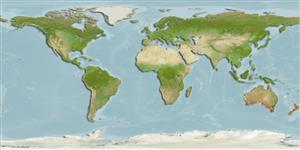Classification / Names
आम नाम | उपशब्द | Catalog of Fishes (gen., sp.) | ITIS | CoL | WoRMS | Cloffa
ऐकटीनोप्टीरेजी (रेज़-फिन्नढ मछलियाँ) >
Mugiliformes (Mullets) >
Mugilidae (Mullets)
Etymology: forsteri: Named for F.C. Aldrich, former Chief Inspector of Fisheries and Game, Western Australia and J.R. Forster, naturalist on Cook's second voyage to New Zealand (Ref. 9003).
पर्यावरण / जलवायु / सीमा
पारिस्थितिकी
; समुद्री; स्वच्छ जल, अलवण जल; खारा ड़िमरसल; कैटाड़रोमस (Ref. 46888); गहराई सीमा 0 - 50 m (Ref. 9003), usually 0 - 10 m (Ref. 9812). Temperate; ? - 28°C (Ref. 28706), preferred ?; 25°S - 47°S, 112°E - 173°W
Southwest Pacific: throughout New Zealand and the Chatham Islands; also from eastern, western Australia, southern Australia and Tasmania.
आकार / वज़न / Age
Maturity: Lm ? range ? - ? cm
Max length : 50.0 cm SL पुल्लिंग / अलिंग; (Ref. 44894); common length : 25.0 cm TL पुल्लिंग / अलिंग; (Ref. 9258); अधिकतम प्रकाशित वज़न: 950.00 g (Ref. 26498); अधिकतम सूचित उम्र: 7 वर्षो (Ref. 9003)
पृष्ठीय रीढ़ (सम्पूर्ण): 5; पृष्ठीय सौफट रेज़ (सम्पूर्ण): 9; गुदा कांटा 3; ऐनल सौफट रेज़: 12. More pointed head and mouth than Mugil cephalus, and their eyes lack adipose (fatty) eyelids. Body scales are small (54-64 between gill opening and tail base) and thin, and are easily dislodged. 2 widely separated dorsal fins, the first with 4 spines and the second with 1 spine and 9 rays. These fish are olive or bluish brown above and silvery on the sides, and their eyes are bright yellow or golden. The fins have brown margins.
Found over sandy and muddy bottoms of coastal waters, bays, estuaries, and may ascend rivers into freshwaters (Ref. 9812, 44894). Adults inhabit brackish coastal lakes (Ref. 44894). Found in schools (Ref. 9812). Shoal-forming (Ref. 44894). They are omnivores, feeding mostly on benthic detritus, algae and small invertebrates. Oviparous, eggs are pelagic and non-adhesive (Ref. 205). Spawn in coastal waters in summer and autumn, probably in estuaries (Ref. 9812, 27012, 28470, 28707, 28708). Marketed fresh (whole gutted or fillets), smoked, salted or as roe (Ref. 3383).
Yellow eye mullet form large aggregations prior to spawning (Ref. 6390).
Kailola, P.J., M.J. Williams, P.C. Stewart, R.E. Reichelt, A. McNee and C. Grieve, 1993. Australian fisheries resources. Bureau of Resource Sciences, Canberra, Australia. 422 p. (Ref. 6390)
IUCN Red List Status (Ref. 115185)
CITES (Ref. 94142)
Not Evaluated
Human uses
मात्स्यिकी: व्यापारिक; आखेट मत्स्य: हां
अधिक जानकारी
सहयोगीयोतस्वीरेStamps, Coinsध्वनिसिगुयटिरारफ्तारतैरने के प्रकारगिल क्षेत्रOtolithsदिमागदृष्टि
साधन
Special reports
Download XML
इंटरनेट स्रोत
